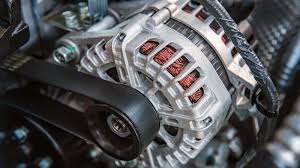WirralCar Repairs
Alternator
- Pulley
- Rotor
- Stator
- Voltage Regulator
- Rectifier

Common Issues
- Dim or overly bright lights
- Your battery is dead
- Slow or malfunctioning accessories
- Trouble starting or frequent stalling
- Growling or whining noises
- Smelling burning rubber or wires
- Lit up battery warning light on dash

WHAT IS A CAR ALTERNATOR?
When it comes to powering your car's radio, headlights, and other electronic components, you may think it's the battery that's putting in all the work. In reality, it's your alternator that keeps things up and running. But what exactly does an alternator do, and how does it work?
an Alternator looks like a small cylindrical generator. You will typically find it bolted to the engine. A car alternator, along with the battery and voltage regulator, is one of three main parts of a vehicle’s electric charging system. What an alternator does is supply electricity to be stored in a vehicle’s battery. It is the alternator’s function to take in mechanical power from a drive belt or serpentine belt connected to the engine’s crankshaft pulley and then convert this mechanical energy into electricity.
HOW DOES AN ALTERNATOR WORK?
While the battery is essential for starting your car when it's off, the alternator keeps your car alive when the engine is running. The alternator powers most of the car's electronic components while you're driving around or idling, including your headlights, electric steering, power windows, windshield wipers, heated seats, dashboard instruments, and radio. The alternator supplies all of them with direct current (DC) energy. Your alternator is also responsible for charging your car battery while driving.
The alternator works by turning mechanical energy into electrical energy. When your engine is on, it powers a drive belt that rests on a pulley attached to the alternator. The pulley turns the alternator's rotor shaft, which spins a set of magnets inside a coil. These spinning magnets generate alternating current (AC) in the stator, which is then channelled to the alternator's rectifier. The rectifier converts that AC energy into DC energy, which activates your car's electrical systems.
Alternators can typically last the lifetime of your vehicle, but that doesn't always happen. General wear and tear, heat damage, overuse, exposure to water, faulty parts, or frayed wires can put your alternator out of commission before your car heads to the scrap yard.
WARNING SIGNS OF A BAD ALTERNATOR
Without a working alternator, your car won't start in the near future or stay on for more than a few minutes. Yet the typical signs of a bad alternator are often mistaken for problems with the battery or other car parts that display similar symptoms. In other words, if you're experiencing only one of the issues below, it may be a sign of a bad alternator:
- Dim or overly bright lights
- Your battery is dead
- Slow or malfunctioning accessories
- Trouble starting or frequent stalling
- Growling or whining noises
- Smelling burning rubber or wires
- Lit up battery warning light on dash
KEEP YOUR CAR CHARGED UP
Difficulties when starting your vehicle or charging your battery could be due to a faulty alternator! For professional diagnostics and transparent service recommendations, schedule an electrical system inspection or an alternator service at your nearest workshop.